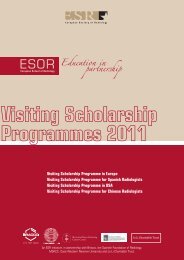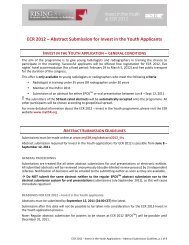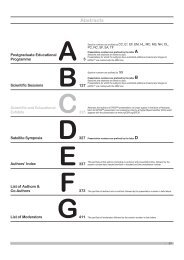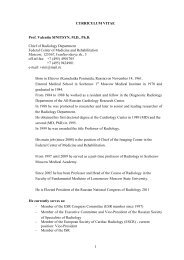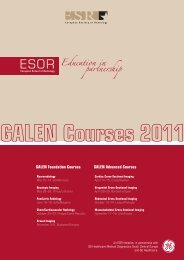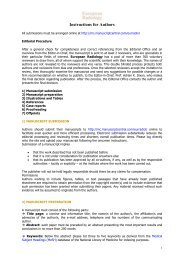Postgraduate Educational Programme - myESR.org
Postgraduate Educational Programme - myESR.org
Postgraduate Educational Programme - myESR.org
- No tags were found...
Create successful ePaper yourself
Turn your PDF publications into a flip-book with our unique Google optimized e-Paper software.
<strong>Postgraduate</strong> <strong>Educational</strong> <strong>Programme</strong>h) and Lesions of the basal ganglia, the perirolandic cortex and the brain stemdue to acute total asphyxia (10-15 min) comprise the spectrum of lesions followinghypoxia ischaemia in the full-term baby. Stroke is an important cause of mortalityand morbidity in the neonatal period. Neonatal stroke is less common than adultstroke but more common than that in childhood and the carotid artery territory ismost commonly affected.Learning Objectives:1. To understand gestational age-related patterns of brain injury.2. To understand the role of ultrasound and MRI for the initial diagnosis andfollow‐up of these patients.3. To understand when and how to use advanced MRI techniques for delineationof lesions and for prognosis.A-120 11:00B. Spine and spinal cord malformationsA. Rossi; Genoa/IT (andrearossi@ospedale‐gaslini.ge.it)Spinal and spinal cord malformations are collectively named spinal dysraphisms.They arise from defects occurring in the early embryological stages of gastrulation(weeks 2-3), primary neurulation (weeks 3-4), and secondary neurulation (weeks5-6). They are categorized into open spinal dysraphisms, in which there is exposureof abnormal nervous tissues through a skin defect, and closed spinal dysraphisms,in which there is a continuous skin coverage to the underlying malformation. Openspinal dysraphisms basically include myelomeningocele and other rare abnormalitiessuch as myelocele and hemimyelo (meningo)cele. Closed spinal dysraphismsare further categorized based on the association with low-back subcutaneousmasses. Closed spinal dysraphisms with mass are represented by lipomyelocele,lipomyelomeningocele, meningocele, and myelocystocele. Closed spinal dysraphismswithout mass comprise simple dysraphic states (tight filum terminale,filar and intradural lipomas, persistent terminal ventricle, and dermal sinuses) andcomplex dysraphic states. The latter category further comprises defects of midlinenotochordal integration (basically represented by diastematomyelia) and defectsof segmental notochordal formation (represented by caudal agenesis and spinalsegmental dysgenesis). Magnetic resonance imaging is the preferred modality forimaging these complex abnormalities. The use of the aforementioned classificationscheme is greatly helpful to make the diagnosis.Learning Objectives:1. To understand the embryology underlying the different categories of malformations.2. To learn the key morphological features.3. To learn how to use a simplified diagnostic imaging approach.A-121 11:30C. Imaging of the foetal brainC. Garel; Paris/FR (catherine.garel@trs.aphp.fr)The foetal brain undergoes changes throughout pregnancy according to a specifictiming. Hence, the changing appearance of the cerebral parenchyma over time,the development of the different sulci and the structures of the posterior fossamust be well known in order to provide an accurate analysis of the fetal brain.Ultrasonography (US) is the imaging modality of choice for routine evaluation ofthe fetal brain. In favourable conditions, it enables detection of most cerebral abnormalities.The acquisition of images in the three planes of the space is mandatory.When available, the use of high-frequency probes enhances spatial resolution andmay provide important details regarding brain anatomy. The different structures ofthe brain must be systematically analysed. Magnetic Resonance Imaging (MRI)provides excellent images whatever the foetal position and the thickness of thematernal wall but may be hampered by foetal motion. It is important to be aware ofthe contribution of the different sequences. The contrast resolution is better with MRIthan with US. Imaging findings of the most common cerebral abnormalities will bedisplayed with emphasis on respective contribution, limitations and indications forboth imaging modalities. For instance, certain lesions, such as focal parenchymalcalicifications, may be overlooked by MRI. Conversely, other lesions such as focalhaemorrhage or subependymal tubers may be missed by US. Awareness of theselimitations is of utmost importance.Learning Objectives:1. To become familiar with the normal appearance of the developing brain.2. To learn about the protocols and the limitations of foetal imaging.3. To gain knowledge about the imaging findings of the most common brainabnormalities.10:30 - 12:00 Room I/KJoint Course of ESR and RSNA (Radiological Society of NorthAmerica)MC 528Essentials in oncologic imaging: what radiologistsneed to know (part 2)Moderator:H. Hricak; New York, NY/USA-122 10:30A. Pancreatic cancerF. Caseiro‐Alves; Coimbra/PT (caseiroalves@gmail.com)Despite advances in cross-sectional techniques, imaging has still difficulties on assessingpancreatic tumours and in particular adenocarcinoma. The main problemsremain the early detection of small tumours and the clearcut definition of patientsthat are amenable to curative surgery. After reviewing current concepts in theclassification of pancreatic tumours including the role of molecular biomarkers, thelecture will address the strategies that may be used to maximize tumour conspicuityin a multi-modality perspective that also encompasses uprising techniques, suchas dual energy CT, perfusion CT/MR and diffusion-weighted MRI. The concept ofborderline resectable pancreatic cancer will be explained as well as the key pointsfor image interpretation in the setting of clinical decisions for patient management.In addition, the current role of adjuvant or neoadjuvant therapy will be shortly addressedespecially concerning its imaging implications, as well as the new conceptson pancreatic adenocarcinoma oncogenesis and possible imaging strategies thatmay be used for earlier detection.Learning Objectives:1. To understand current pathologic concepts for the classification of pancreatictumours.2. To learn about imaging findings used for tumour detection, staging, and restagingafter adjuvant therapy.3. To understand the role of functional and molecular information provided byPET/CT, DWI and perfusion imaging when assessing pancreatic tumours.A-123 10:55B. Kidney cancerE.K. Fishman; Baltimore, MD/US (efishman@jhmi.edu)Carcinoma of the kidney is responsible for over 100,000 deaths worldwide eachyear. With advances in radiologic imaging up to two-thirds of renal cancers arepicked up as serendipitous findings. Despite multiple advances in imaging challengesin lesion classification remain and may result in up to one fourth of lesionsunder 3 cm being resected being benign lesions. In this presentation we will focuson the role of CT in the detection, staging and management of the patient withrenal cell carcinoma discussing both renal cell carcinoma (clear cell and papillary)and transitional cell carcinoma. The importance of proper protocol design, the useof multiphase acquisition and the value of 3D mapping will be discussed. The roleof CT in staging tumours and its role in surgical planning will also be addressed.New understanding of how CT findings on arterial phase imaging closely correlatewith the genetic findings is also addressed. The pitfalls in lesion detection andclassification are also addressed and case examples of some of the pitfalls areprovided. Protocols for the use of imaging as well as the use of dose reductiontechniques including iterative reconstruction are addressed.Learning Objectives:1. To understand the diagnostic implications of minimally invasive treatments ofrenal cancer.2. To review the genetic causes of renal cancer and the radiologic appearancesof specific histologic subtypes.3. To review the potential role of molecular imaging in the management of advancedrenal cancer.Author Disclosure:E. K. Fishman: Advisory Board; GE, Siemens. Board Member; HipGraphics Inc.Founder; HipGraphics Inc. Research/Grant Support; GE, Siemens.S34AB C D E F G



